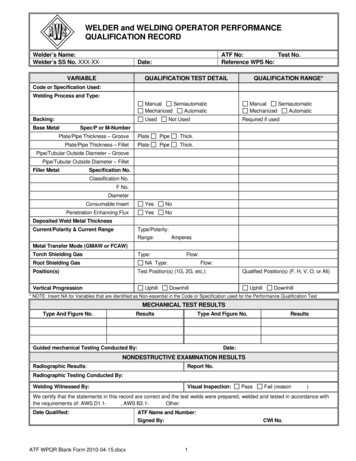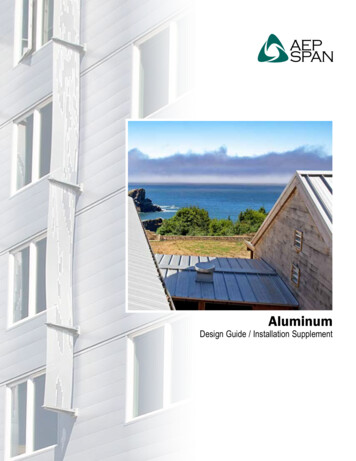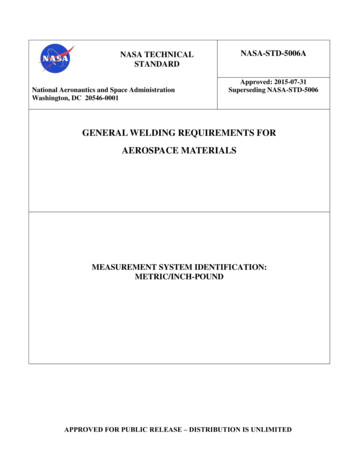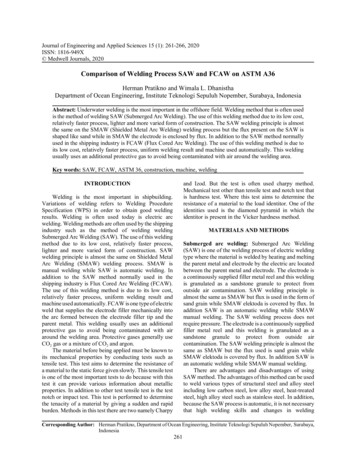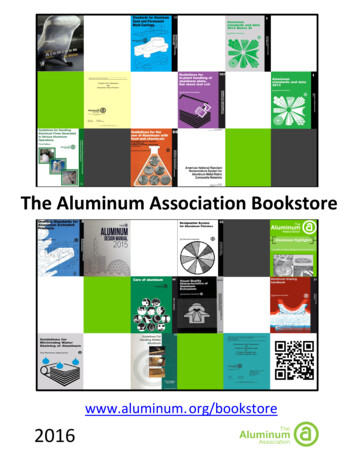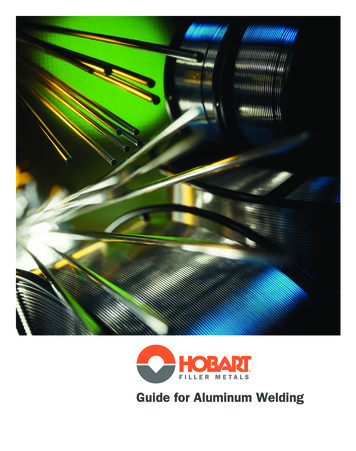
Transcription
Guide for Aluminum Welding19-0XXXX Maxal-AluminumProductGuide 46pg-LA2.indd 13/5/19 1:29 PM
The Welder’s Choice forQuality Aluminum Weld WireAs a premium filler metal solution, Hobartaluminum wire is supported and manufactured bya team with decades of expertise in aluminum fillermetals. It’s produced from a state-of-the-art facility,entirely built around aluminum wire production,with custom-built equipment and proprietaryprocesses and production techniques.Hobart’s expertise and customized, innovativemanufacturing processes provide aluminum weldwire with excellent soft-start characteristics andminimal burn back. Manual applications achievea greater weld bead quality. Hobart wire alsofeatures superior feedability with reduced birdnesting, extended liner and contact tip life, andexcellent x-ray quality.Hobart has gained recognition in the industryas a premium aluminum filler metal brandwith unmatched product quality, reliability andperformance. As a part of the ITW WeldingNorth America portfolio, Hobart wire and feedingsolutions will be combined with Miller, Bernard,Tregaskiss, and Weldcraft to create the bestaluminum welding systems available.Technical Assistance: 877-629-2564To Place An Order: 800-424-1543*Hobart Brothers LLC disclaims liability for anyinjury to persons or to property, or other damagesof any nature whatsoever, whether special,indirect, consequential, or compensatory, directlyor indirectly resulting from the publication, use of,or reliance on this Guide for Aluminum Welding.Hobart Brothers Company also makes no guaranteeor warranty as to the accuracy or completeness ofany information published herein.19-0XXXX Maxal-AluminumProductGuide 46pg-LA2.indd 2ITW Welding3/5/19 1:29 PM
TheWay – Product DifferentiationIt is not merely the innovative manufacturing methods and techniques which make the Hobart product“best in class”. The quality and meticulous attention to detail in every facet of delivering the productinto the customer’s hands are also a high priority. It is a well known fact that aluminum requiresspecial procedures to work with and therefore the aluminum welding material must be able to meetall requirements.The key criteria in the Hobart product are as follows:Extreme cleanliness (able to exceed the AWS porosity standard)Outstanding feedabilitySuperior arc stabilitySuperior arc startsExcellent welder appealRepeatability and consistencyWire diameter control (1/10th of allowed AWS specification)All these features available in a wide range of alloysPlant and product certifications ISO 9001, AWS, CWB, ABS, ASME, CE, VdTUV and YesYesYesYesYesYesYesYesYesThe quality does not end here, the product then needs to be packaged and delivered to the customer.To ensure the product arrives in the same condition when it left the factory, great detail has been givento the packaging. Some of the unique features are as follows:Spools and Baskets (MIG): A sturdy 12” spool double walled reusable box with top entry No taping of the box flap due to snug fitting closure A sturdy wire basket spool; the strongest in the industry Heavy weight plastic bag for better atmospheric protection 8” 5 lb., 12” 16 lb. and 22 lb. plastic spools available Unique alloy selection guide on side of all boxes (MIG and TIG)Straight Lengths (TIG): Revolutionary TIG box with zipper style end cap for removal of a few rods then replaced for protection Inner liner in TIG box adds to sturdiness, provides snug fit, rods stretch wrapped in bundleseliminates moisture and fretting corrosion Master TIG carton holds 4 boxesDrums 300# drum, 100# drum and 50# ergo pac drum provide tangle free feeding with minimal utilization ofdispensing systems Multi-sided for extra sturdiness, adapts to most currently available cones Double walled with plastic sealable bag between walls for moisture protection Unique self contained pallet for maneuverability eliminates use of lifting straps which can damagedrums and wire Two individual drums per skidConsidering all the above including an extensive range of welding filler metals with the unparalleledtechnical expertise and services, Hobart Aluminum is the only choice for your aluminum welding solutions.19-0XXXX Maxal-AluminumProductGuide 46pg-LA2.indd 33/5/19 1:29 PM
Hobart Guide for Aluminum WeldingWeldingProcedureSpecificationGeneral Technical Assistance for Aluminum Design Engineers, Process Engineers & WeldersAll commercial welding operations should have a written Welding Procedure Specification (WPS) for each weldmentthat is produced. This booklet provides guidance in determining the key technical elements required to produce areliable WPS and achieve a successful welding outcome.The following uses the flow of a typical Welding Procedure Specification (WPS) as the guideline for itsorganization, with a sample WPS form shown on page vingWeldingProceduresWeld Preparation& TreatmentsFiller MetalBase MetalWelding Procedure SpecificationPage 3. WPS Sample FormBase MetalProblem SolvingPage 22.Obtaining a Stable Arc and Eliminating ErraticFeeding and BurnbacksPurchasing Contact Tips and MaintenanceSuggestionsPage 23.Drive Roll Design and Wire FeedabilityPage 24.Weld Joint PorosityPage 25.Tips for Reducing Weld Joint PorosityPage 26.Calculation of Dew PointFiller MetalPage 27.How to Avoid Cracking in Aluminum AlloysPage 29.Weld Discoloration, Spatter and Black SmutPage 8. Guidelines For Selecting the Most AppropriatePage 30.Weld Bead Root Penetration and FusionFiller Metal (4043 or 5356)Page 31.Weld Bead Contour and PenetrationPage 9. MAXAL Mig R4943 and MAXAL Tig R4943Guidelines For Elevated Temperature Applications Page 32.Solving Weld Profile ProblemsPage 33.The Guided Bend TestPage 10. Selecting the Correct Filler Metal to MatchPage 34.The Transverse Tension TestAnodized ColorNon-Weldable Aluminum Base MetalsSpecifications(Arc Welding)Page 35.Chemistry Certifications: AWS ClassificationsPage 11. Nominal Compositions of Wrought Alloys andPage 36.American Welding Society Control DocumentsTypical Physical PropertiesPage 4. Alloy and Temper DesignationsPage 5. Alloy and Temper ApplicationsPage 6. Heat Treatable and Non-Heat Treatable AlloysPage 7. Welded Properties of 5xxx and 6xxx SeriesBase MetalsWeld Preparation & TreatmentsPage 12. Cleaning the Base Metal before WeldingMetal Storage and Weld Joining Preparation Do’s and Don’tsPage 13. Weld BackingPreheating and Interpass TemperaturesPost-Weld Heat Treatment and AgeWelding ProceduresInformation SourcesPage 37.Welding Design Information and TechnicalAssistancePage 38.Conversion TablesThe MAXAL CommitmentPage 39.Traceability of Electrode and RodCertifications and Society ApprovalsQuality of Electrode and RodCustomer SupportPage 40.Advanced Aluminum Welding Technology SeminarPage 14. Electrodes for Aluminum TIG WeldingShielding Gases Used for MIG and TIG WeldingPage 15. MIG and TIG Joint GeometriesMiller Solutions Made for AluminumMIG Equipment Set-Up ParametersPage 16. Typical MIG Parameters for Groove Welds InPage 41. Miller SolutionsAluminumPage 42. Industrial Aluminum MIG SolutionsPage 17. Typical MIG Parameters for Fillet Welds InIndustrial Aluminum TIG SolutionsAluminumPage 18. Typical TIG Parameters for Groove Welds InAluminumPage 19. Typical TIG Parameters for Fillet Welds InAluminumPage 20. Preferred Mode of Metal Transfer to be UsedWhen MIG Welding AluminumPage 21. Pulsed Spray Transfer MIG Welding of Aluminum19-0XXXX Maxal-AluminumProductGuide 46pg-LA2.indd 43/5/19 1:29 PM
Welding Procedure SpecificationSpecificationsDateDateBase MetalAWS M-No.AlloyApprovedApprovedWelding ProceduresTemper Section ThicknessProcess: MIGTIGShielding Gas:TypeFlow RateFiller MetalAWS F-No.AWS ClassWelding wire diameterWelding wire type: MIGTIGMixtureGas Cup SizeWeld Description: GrooveWeld Position:Weld Preparation & TreatmentsCleaning:Oxide removalHydrocarbon/contaminant removalEtchSolventWashInterpass cleaning:YesNoInterpass cleaning methodPreheat:YesNoPreheat temperatureInterpass temperature ationSpecification No.RevisionsPQR NumbersCertification Specifications & CodesRemovePost-Weld Heat Treatment & Age:Original temperSolution temp.Time at temp.Quench type & temp.Age temp.Age timeProgression:Weld Pass Type:StringerOscillationBack Gouging:YesNoFilletWeaveOtherMethodWelding Pass ing Sequence Sketch:Weld Profile Picture:The Welder’s Choice forQuality Aluminum Weld Wire319-0XXXX Maxal-AluminumProductGuide 46pg-LA2.indd 53/5/19 1:29 PM
Base MetalAlloy And Temper DesignationsAluminum Alloy Compositions - Aluminum Association Numbering SystemWrought AlloysCasting Alloys Principal Alloying ElementsBase 99.00% Minimum AluminumCopperSilicon Copper and/or MagnesiumSiliconMagnesiumUnused SeriesZincTinOther ElementsAluminum Alloy Tempers - Aluminum Association Designations-F-O-H-W-TAs fabricatedAnnealedStrain hardened- H1- Strain hardened only- H2- Strain hardened and partially annealed- H3- Strain hardened and stabilized- H4- Strain hardened and lacquered or paintedSolution heat-treatedThermally treated- T1- Naturally aged after cooling from an elevated temperature shaping process- T2- Cold worked after cooling from an elevated temperature shaping processand then naturally aged- T3- Solution heat-treated, cold worked, and naturally aged- T4- Solution heat-treated and naturally aged- T5- Artificially aged after cooling from an elevated temperature shaping process- T6- Solution heat-treated and artificially aged- T7- Solution heat-treated and stabilized (over aged)- T8- Solution heat-treated, cold worked, and artificially aged- T9- Solution heat-treated, artificially aged, and cold worked- T10- Cold worked after cooling from an elevated temperature shaping processand then artificially aged- TX51 - Stress relieved by stretching- TX52 - Stress relieved by compression419-0XXXX Maxal-AluminumProductGuide 46pg-LA2.indd 63/5/19 1:29 PM
Alloy And Temper ApplicationsMost Commonly Used Wrought Aluminum Base MetalsWrought Alloys Typical Tempers1xxx (pure)13501100- F, -O-O, -H142xxx (Cu)2219-T63xxx (Mn)3003-O, -H126xxx (Mg/Si)60616063600560096111-T6, -T651-T5-T5Electrical bus barsFormability (deep drawing etc.), corrosion resistance (chemical tanks)High strength-to-weight ratio (aerospace), large service temperature rangeFormability and high temperature service (heat exchangers, cookware)Base Metal5xxx (Mg)5052-O, -H345454-O, -H345086-H32, -H345083-H325456-H32Applications and FeaturesFormability, corrosion resistance, and low cost (roll forms, auto, trailers,truck trailer sheeting)Elevated temperature applications (wheels)Strength and toughness (shipbuilding, boats)High strength, good saltwater corrosion resistance (shipbuilding), cryogenic applicationHigh strength-to-weight ratio (pressure vessels, tanks)High strength and toughness (truck trailer, rail cars)Strength and good anodizing properties (architectural applications, automotive trim)Cost efficient extrusions (auto, architectural applications)7xxx (Zn)7005Copper-free 7xxx alloys which are good for extrusions.7021-T53, -T63Good toughness and formability. (automotive, truck, ships railings,7029bumper supports, sports products such as bats, bikes etc.)7146Note: Alloys 2024, 7075 and 7050 are considered non-weldable by the arc welding process. See page 9.Most Commonly Used Cast Aluminum AlloysCasting AlloysTypical TempersNon-Heat TreatableableHeat Treat-Applications and Features2xx.x201.0Limited Weldability206.0Limited Weldability224.0Limited Weldability3xx.x (Si Cu and/or Mg)319.0x Elevated temperature strength (auto pistons)333.0x Elevated temperature strength (diesel pistons)354.0x(auto accessories, crank cases)C355.0x (aircraft, missiles)A356.0 (356.0)xGeneral purpose structuralA357.0x High strength (aerospace)359.0x High impact strength (aircraft structural)380.0xGeneral purpose4xx.x (Si)443.0xPressure tight (marine, valves)A444.0x5xx.x (Mg)511.0xGood anodizing properties (architectural)512.0x(fittings, cooking utensils)513.0x514.0x Excellent corrosion resistance (chemical processing, marine)7xx.0 (Zn)710.0x Good brazing characteristics712.0x (general purpose, corrosion resistant applications)519-0XXXX Maxal-AluminumProductGuide 46pg-LA2.indd 73/5/19 1:29 PM
Heat Treatable And Non-Heat Treatable AlloysThis section presents a discussion about the properties, before and after welding, of heat treatable vs. non-heattreatable aluminum alloys. This is an area of concern for anyone attempting to choose the best base materialalloys and tempers and the correct filler materials to join them. It is in this area that manufacturers have difficultyachieving consistent mechanical properties and defect free weldments in production. For purposes of discussion thissection will limit the dialog to a comparison of the 6xxx and 5xxx series alloys:Base MetalThe 6xxx series base metals have low alloy content and are easy for mill product fabricators to form intoextrusions, tubing, forgings and other shaped products and then to heat treat to obtain high mechanicalproperties, making them economical to produce. The 5xxx series base metals have high alloy content andbecause of their strain hardening and higher flow stress characteristics are more costly to fabricate into shapes.However the 5xxx series base metals are economically rolled into sheet and plate and roll formed into shapeswhen specific shapes are desired.The 6xxx series base metals obtain their maximum mechanical properties through heat treatment and aging. Thealuminum metal matrix is strengthened by the precipitation of the alloying elements as intermetallic compoundswhose size and distribution throughout the matrix is carefully controlled through precise thermal operations.When the 6xxx series base metals are welded, the microstructure in the HAZ is degraded and the mechanicalproperties are typically reduced by 30 - 50%. Figure 1 on page 7 shows that 6061 and its most common fillermetal 4043 both have a typical annealed tensile strength of around 19 ksi. Depending on the heat input duringthe welding operation, the base metal can be fully annealed for some distance from the weld, especially in areasbeing weld repaired.The 5xxx series base metals obtain their maximum mechanical properties through alloying element solid solutionstrengthening and additional strength is gained from cold working. The welding operation does not affect thesolid solution strengthening of the base metal, only the cold working portion of the strength is lost in the heataffected zone transforming it to the annealed condition. Figure 1 on page 7 shows that the typical annealedtensile strength of 5083 base metal is 43 ksi.Figure 1 on page 7 compares the loss of strength in the heat affected zone of welded 6061-T6 and 5083-H321wrought base metals.Figure 2 on page 7 shows the loss of strength in the heat affected zone of the as-welded 6061-T4 and -T6 basemetals compared with post-weld aging.The chart on page 7 shows the basic alloying elements and typical ultimate tensile strengths in the non-weldedand as-welded conditions for the most frequently welded 6xxx and 5xxx series base metals. The charts illustrateand are supported by the following important points:1The loss of as-welded strength in the 5xxx base metals is significantly less than that of the 6xxx base metals.2The 6xxx base metal properties shown are dependent on a minimum of 20% dilution of 6xxx base metal intothe 4043 filler metal weld pool. The 5xxx base metals when welded with 5xxx filler metals are not dependenton dilution.3The 6xxx base metals have 30% higher thermal conductivity than the 5xxx base metals making it more difficultto produce consistent quality welds in the 6xxx base metals. Therefore 6xxx base metals require higher heatinput to achieve penetration and this can result in increased distortion of the welded structure.46xxx base metals welded with 5xxx filler metals are more solidification crack sensitive than 5xxx base metalswelded with 5xxx filler-metals. See page 10.5The as-welded mechanical properties of the 6xxx base metals are very sensitive to welding variables such asheat input and joint design whereas the 5xxx base metals are far less sensitive to these variables, makingthe 5xxx as-welded results much more controllable.6As-welded 5xxx base metals welded with 5xxx filler metals have higher ductility, toughness, and crackpropagation resistance than as-welded or post-weld heat treated and aged 6xxx base metals weldedwith 4043.619-0XXXX Maxal-AluminumProductGuide 46pg-LA2.indd 83/5/19 1:29 PM
Welded Properties Of 5xxx And 6xxx Series Base MetalsUn-welded & welded mechanical properties for the most frequently welded 6xxx & 5xxx series base metals.Figure 1Typical properties of 6061-T6 as weldedwith three different heat inputsvs.5083-H321 as welded with high or low heatFigure 2Typical properties of 6061-T4 & T6Base MetalBase Metal&%%TemperSiMgTypical UTS(non-HAZ)ksiTypical UTS(welded)ksiMin. ExpectedUTS (welded)ksiMin. Expected UTS (welded) as a% of Typical UTS .151464282Heat Treatable 6xxx Base Metals6061T60.61.0T4 (PWA)T6 (PWA)T6 (PWH&A)6063T60.40.7(PWA) - post-weld aged(PWH&A) - post-weld heat treated and agedNon-Heat Treatable 5xxx Base Metals5052H322.5H345454H345086H345083H116 & H3215456H116719-0XXXX Maxal-AluminumProductGuide 46pg-LA2.indd 93/5/19 1:29 PM
Filler MetalGuidelines For Selecting The Most Appropriate Filler Metal (4043/4943 or 5356)Selecting the correct filler alloy for aluminum is based on the operating conditions of the finished welded component.It is therefore essential to have the answers to some basic questions prior to the selection of the most appropriatefiller metal.1.2.3.4.5.What is the aluminum base metal designation?Will the welded component be exposed to sustained elevated temperature?Will the completed weldment be subjected to post weld anodizing?Will shear strength, ductility, and toughness be of prime consideration?Is post-weld heat treatment to be performed?Alloys 4043/4943 and 5356 are used in over 85% of all aluminum weldments. If the technical requirements of theweld can be met with either 4043/4943 or 5356, use one of these two alloys because they are readily availableand are the least expensive to purchase. Also consider using the largest recommended diameter wire because thelarger sizes are also less expensive.Filler MetalWhen welding the 5xxx and 6xxx series base metals the following considerations should be made when selectingthe most appropriate filler metal: For 6xxx series base metals, and 5xxx series base metals containing up to 2.5% (nominal) Magnesium useeither 4043/4943 or 5356. For 5xxx series base metals containing more than 2.5% (nominal) Magnesium use 5356 filler metal and do notuse 4043/4943 filler metal. For good anodized color matching use 5356. For higher ductility and toughness use 5356. This will increase resistance to crack propagation.For long term elevated temperature exposure above 150 F use 5554 or 4043/4943. Do not use 5356.For higher shear strength use 5356 or 4943. A rule-of-thumb is that it takes three fillet passes of 4043 toequal the shear strength of one pass of 5356.For reduction of termination and shrinkage cracking use 4043/4943 or 4047.For reduction of welding distortion use 4043/4943 or 4047.For brighter welds with less welding “smut” use 4043/4943.For better feedability through the welding gun use 5356. 5356 is twice as stiff as 4043/4943 and thereforefeeds better. However, MAXAL’s 4043/4943 has excellent feedability.Note: For more detailed information on filler metal selection refer to the Hobart selection chart in the back of this book.819-0XXXX Maxal-AluminumProductGuide 46pg-LA2.indd 103/5/19 1:29 PM
MaxalMig ER4943 and MaxalTig R4943A 25% increase in tensile shear strength and 50% increase in yield strengthAlloy 4943 filler metal was designed to provide a high strength solution with the ease of welding and otheradvantages of 4043. Alloy 4043 filler metal is a popular aluminum/silicon filler alloy for general purpose weldingapplications. Alloy 4943 filler metal was formulated to be welded with the same weld procedure specifications as4043 and 4643, and does not depend upon dilution from the base metal during welding to increase the strengthof the weld deposit, while maintaining the same excellent corrosion characteristics, low melting temperature,low shrinkage rate, higher fluidity, and low hot cracking sensitivity. Welds exhibit low welding smut and lowdiscoloration. 4943 is heat-treatable and exhibits strength levels superior to 4043 and 4643 in post weld ageand post weld heat treat and age conditions.Testing has shown that 4943 will typically provide 25% improved tensile and shear strength as 50% improvedyield strength over 4043 in the as-needed condition.Applications:Automotive/motorcycle framesAerospace hardwareWheelsShip decksFurniture Post weld age, post weld heat treat & age applicationsSports products - scooters/bicyclesGeneral repair and maintenanceAlloy 356 CastingsLadders and framesFiller Metal Current 4043 and 4643 Applications, Welding 1xxx, 3xxx, 4xxx, 5xxx series withup to 2.5% (nominal) Magnesium (Mg) such as 5052 & 6xxx series base metals.(Refer to the Hobart Aluminum filler metal selection chart for further guidance in selectingfiller metals for welding specific base metals.)Strength Comparison, 4043 vs. 4943(All weld metal, GMAW, no base metal dilution)Fillet Weld Strength:The most important benefit of 4943 is to provideconsistently higher strength fillet welds. There are farmore fillet welds than groove welds used in structuralwelded components and unlike full penetration groove weldtransverse tensile strength, which is controlled by the basemetal HAZ, fillet weld shear strength is directly controlledby the strength of the filler metal used during welding. Fillermetal shear strength is proportional to filler metal tensilestrength. Typical shear strength for 4943 is greater than15.5 ksi (4043 published value is 11.5 ksi).Guidelines For Elevated Temperature ApplicationsAlcoa research engineers discovered that stress corrosion cracking (SCC) in 5xxx series alloys can be encounteredwhen used in elevated temperature applications. The research and resultant field performance data showsthat 5xxx series alloys with magnesium contents above 3% are susceptible to SCC when exposed to prolongedtemperatures between 150 and 350 degrees F. With prolonged exposure to these temperatures, precipitates canform in the grain boundaries that are highly anodic to the aluminum-magnesium matrix. It is this continuous grainboundary network of precipitates that produces susceptibility to stress corrosion cracking (SCC) and the potentialfor premature component failure.Base metal 5454 was specifically developed by Alcoa for good strength and ductility characteristics when used inelevated temperature applications. Filler metal ER5554 was developed to weld base metal 5454 and both alloyscontain magnesium contents between 2.4% and 3.0%. Therefore, both alloys are suitable for elevated temperatureapplications and are not susceptible to SCC.Filler metal ER4043 does not have magnesium added to its alloy composition and can be used to weld 5xxxseries alloys with up to 2.5% magnesium (nominal) as well as other base metals suitable for elevated temperatureapplications such as the 1xxx, 3xxx and 6xxx base metals.919-0XXXX Maxal-AluminumProductGuide 46pg-LA2.indd 113/5/19 1:29 PM
Selecting The Correct Filler Metal To Match Anodized ColorIf post-weld anodizing is to be performed it is important to select the correct filler metal to match color with abase metal after anodizing.The classic example of what NOT to do is to weld 6xxx series base metals with 4xxx filler metals and then anodizethe end product. The 6xxx series base metals will anodize bright and clear while the 4xxx filler metals anodizedark and gray in color because of the free silicon content in the 4xxx series alloys. Refer to the list of alloychemistries on page 10 of this booklet and follow the recommendations in the column for post-anodized color.Also, evaluate the ratings for color match after anodizing in the aluminum filler metal selection chart in the backof this booklet.Non-Weldable Aluminum Base Metals (Arc Welding)Aluminum base metals that are referred to as “non-weldable” are base metals that have an elevated solidificationcracking tendency and in some cases have an increased susceptibility to stress corrosion cracking in theas-welded condition. These base metals are unsuitable for arc welding applications.Some of the base metals that have these tendencies and susceptibilities are as follows:Filler Metal6262 and 2011 (Used for screw machine stock applications.)These two base metals have lead, bismuth, and/or tin added in small quantities to facilitate machinability. Thesesmall additions of low melting point metals seriously increase their solidification cracking tendency. Therefore,these base metals are typically mechanically fastened rather than welded.2xxx series alloys containing, aluminum-copper-magnesium(Used for aerospace and other high performance applications.) Examples: 2017 and 2024These types of base metals can be susceptible to stress corrosion cracking and premature failure if arc welded.Note: There are other 2xxx series base metals such as 2219 which are aluminum-copper alloys with nomagnesium added that are considered weldable.7xxx series alloys, aluminum-zinc-copper-magnesium(Used for aerospace and other high performance applications.) Examples: 7075, 7178, 7050, and 7150These types of base metals can be susceptible to stress corrosion cracking and premature failure if arc welded.Note: There are other 7xxx series base metals such as 7005 which are aluminum-zinc-magnesium metals withno copper added that are considered weldable.Explanation:In the heat affected zone of the non-weldable 2xxx and 7xxx series alloys, low melting point elements are preferentiallyprecipitated into the grain boundaries which lowers and widens the solidification temperature range of the grainboundary. Consequently, when arc welding these types of base metals, the grain boundaries become the last tosolidify and can easily crack due to solidification shrinkage stresses. In addition, the difference in galvanic potentialbetween the grain boundaries and the remainder of the grain structure in these alloys is increased, making them moresusceptible to stress corrosion cracking. These base metals are typically mechanically fastened rather than arc welded.Note: Some of these base metals are presently being welded with the friction stir welding (FSW) process, whichoperates at lower temperatures than arc welding and does not melt the base metal during welding therebyeliminating solidification problems.1019-0XXXX Maxal-AluminumProductGuide 46pg-LA2.indd 123/5/19 1:29 PM
Nominal Compositions Of Wrought Alloys And Typical Physical PropertiesTypical Base Metal and Filler Metal PropertiesAlloyAWS Weld- MeltingDensityPost%D1.2 abilityCuSiMnMgZnCrZrRangelb/in3 AnodizedAlGroup F .097GrayD. –––7075 er MetalER1100F21201420242219 nlM24All ER-class alloys have a maximum Be content of 0.0003. A – Readily weldableB – Weldable in most applications, requires a qualified welding procedurenl – Also contains 0.10% VanadiumC – Limited weldability, caution; consult reference document before weldingTypical Filler Metal PropertiesWeldAlloyDuctility(% 75183535655545556Good (25)Good (25)High (35)High (40)Good (25)ToughnessResistanceTo CrackGrowth(55)(15)(13)(15)(15)ResistanceMin. Shear StrengthToFillet Welds ll Filler Metal WeldTypical UltimateTensile Strength(ksi)GoodLowLowLowLowGoodVery GoodExcellentGoodVery GoodLow (7.5)Low (11.5)Low (11.5)Med. (13.5)Med. (15.5)Low (7.5)Low (15.0)Low (15.0)Med. (20.0)Med. (23.0)Low (13)Low (28)High (38)Med. (29)Med. (35)HighHighV. HighV. HighHighGoodGoodGoodFairGoodHigh (20.0)High (18.5)High (18.0)Med. (17.0)High (20.0)High (30.0)High (28.0)High (26.0)Med. (23.0)High (30.0)High (42)High (41)High (38)Med. (33)High (42)1119-0XXXX Maxal-AluminumProductGuide 46pg-LA2.indd 133/5/19 1:29 PM
Weld Preparation & TreatmentsCleaning The Base Me
Guide for Aluminum Welding. 19-0XXXX_

